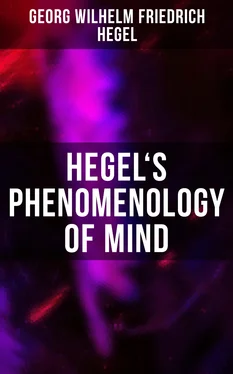Self-consciousness has before it another self-consciousness; it has come outside itself. This has a double significance. First it has lost its own self, since it finds itself as an other being; secondly, it has thereby sublated that other, for it does not regard the other as essentially real, but sees its own self in the other.
It must cancel this its other. To do so is the sublation of that first double meaning, and is therefore a second double meaning. First, it must set itself to sublate the other independent being, in order thereby to become certain of itself as true being, secondly, it thereupon proceeds to sublate its own self, for this other is itself.
This sublation in a double sense of its otherness in a double sense is at the same time a return in a double sense into its self. For, firstly, through sublation, it gets back itself, because it becomes one with itself again through the cancelling of its otherness; but secondly, it likewise gives otherness back again to the other self-consciousness, for it was aware of being in the other, it cancels this its own being in the other and thus lets the other again go free.
This process of self-consciousness in relation to another self-consciousness has in this manner been represented as the action of one alone. But this action on the part of the one has itself the double significance of being at once its own action and the action of that other as well. For the other is likewise independent, shut up within itself, and there is nothing in it which is not there through itself. The first does not have the object before it only in the passive form characteristic primarily of the object of desire, but as an object existing independently for itself, over which therefore it has no power to do anything for its own behalf, if that object does not per se do what the first does to it. The process then is absolutely the double process of both self-consciousnesses. Each sees the other do the same as itself; each itself does what it demands on the part of the other, and for that reason does what it does, only so far as the other does the same. Action from one side only would be useless, because what is to happen can only be brought about by means of both.
The action has then a double entente not only in the sense that it is an act done to itself as well as to the other, but also in the sense that the act simpliciter is the act of the one as well as of the other regardless of their distinction.
In this movement we see the process repeated which came before us as the play of forces; in the present case, however, it is found in consciousness. What in the former had effect only for us [contemplating experience], holds here for the terms themselves. The middle term is self-consciousness which breaks itself up into the extremes; and each extreme is this interchange of its own determinateness, and complete transition into the opposite. While qua consciousness, it no doubt comes outside itself, still, in being outside itself, it is at the same time restrained within itself, it exists for itself, and its self-externalization is for consciousness. Consciousness finds that it immediately is and is not another consciousness, as also that this other is for itself only when it cancels itself as existing for itself, and has self-existence only in the self-existence of the other. Each is the mediating term to the other, through which each mediates and unites itself with itself; and each is to itself and to the other an immediate self existing reality, which, at the same time, exists thus for itself only through this mediation. They recognize themselves as mutually recognizing one another.
This pure conception of recognition, of duplication of self-consciousness within its unity, we must now consider in the way its process appears for self-consciousness. It will, in the first place, present the aspect of the disparity of the two, or the break-up of the middle term into the extremes, which, qua extremes, are opposed to one another, and of which one is merely recognized, while the other only recognizes.
Self-consciousness is primarily simple existence for self, self-identity by exclusion of every other from itself. It takes its essential nature and absolute object to be Ego; and in this immediacy, in this bare fact of its self-existence, it is individual. That which for it is other stands as unessential object, as object with the impress and character of negation. But the other is also a self-consciousness; an individual makes its appearance in antithesis to an individual. Appearing thus in their immediacy, they are for each other in the manner of ordinary objects. They are independent individual forms, modes of Consciousness that have not risen above the bare level of life (for the existent object here has been determined as life). They are, moreover, forms of consciousness which have not yet accomplished for one another the process of absolute abstraction, of uprooting all immediate existence, and of being merely the bare, negative fact of self-identical consciousness; or, in other words, have not yet revealed themselves to each other as existing purely for themselves, i.e., as self-consciousness. Each is indeed certain of its own self, but not of the other, and hence its own certainty of itself is still without truth. For its truth would be merely that its own individual existence for itself would be shown to it to be an independent object, or, which is the same thing, that the object would be exhibited as this pure certainty of itself. By the notion of recognition, however, this is not possible, except in the form that as the other is for it, so it is for the other; each in its self through its own action and again through the action of the other achieves this pure abstraction of existence for self.
The presentation of itself, however, as pure abstraction of self-consciousness consists in showing itself as a pure negation of its objective form, or in showing that it is fettered to no determinate existence, that it is not bound at all by the particularity everywhere characteristic of existence as such, and is not tied up with life. The process of bringing all this out involves a twofold action — action on the part of the other and action on the part of itself. In so far as it is the other’s action, each aims at the destruction and death of the other. But in this there is implicated also the second kind of action, self-activity; for the former implies that it risks its own life. The relation of both self-consciousnesses is in this way so constituted that they prove themselves and each other through a life-and-death struggle. They must enter into this struggle, for they must bring their certainty of themselves, the certainty of being for themselves, to the level of objective truth, and make this a fact both in the case of the other and in their own case as well. And it is solely by risking life that freedom is obtained; only thus is it tried and proved that the essential nature of self-consciousness is not bare existence, is not the merely immediate form in which it at first makes its appearance, is not its mere absorption in the expanse of life. Rather it is thereby guaranteed that there is nothing present but what might be taken as a vanishing moment — that self-consciousness is merely pure self-existence, being-for-self. The individual, who has not staked his life, may, no doubt, be recognized as a Person; but he has not attained the truth of this recognition as an independent self-consciousness. In the same way each must aim at the death of the other, as it risks its own life thereby; for that other is to it of no more worth than itself the other’s reality is presented to the former as an external other, as outside itself; it must cancel that externality. The other is a purely existent consciousness and entangled in manifold ways; it must view its otherness as pure existence for itself or as absolute negation.
Читать дальше












